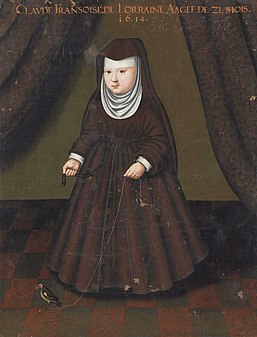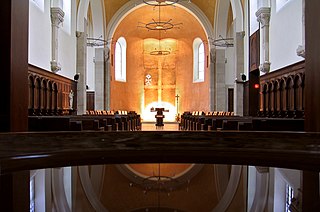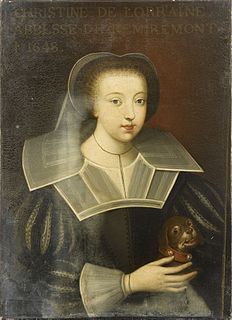
In Christianity, an abbess is the female superior of a community of nuns, which is often an abbey.

Marie de Rohan was a French courtier and political activist, famed for being the center of many of the intrigues of the first half of the 17th century in France. In various sources, she is often known simply as Madame de Chevreuse.

Antoinette de Bourbon Duchess of Guise was a French noblewoman of the House of Bourbon. She was the wife of Claude of Lorraine, Duke of Guise. Through her eldest daughter, Mary of Guise, Queen consort of King James V of Scotland, she was the maternal grandmother of Mary, Queen of Scots.

Françoise d'Alençon was the eldest daughter of René of Alençon and Margaret of Lorraine, and the younger sister and despoiled heiress of Charles IV, Duke of Alençon.
Dirk II or Theoderic II was Count in Frisia and Holland. He was the son of Count Dirk I and Geva.

Claude of Lorraine was a daughter of Henry II, Duke of Lorraine, and Margerita Gonzaga, her sister was Nicole, Duchess of Lorraine. She married her first cousin and was the Duchess of Lorraine by marriage.

Jouarre Abbey is a Benedictine abbey in Jouarre in the département of Seine-et-Marne.

Anne Charlotte of Lorraine was the Abbess of Remiremont and Mons. She was the thirteenth of fifteen children of Leopold, Duke of Lorraine, and his spouse Élisabeth Charlotte d'Orléans. Her mother was the niece of Louis XIV of France and sister of Philippe II, Duke of Orléans and Regent of France during the minority of Louis XV.
Henriette Louise de Bourbon was a French princess by birth and a member of the House of Bourbon. She was the abbess of Beaumont-lès-Tours Abbey.
Élisabeth Charlotte of Lorraine was a Princess of Lorraine. She died of smallpox aged 10. She was the Titular Abbess of Remiremont.

Catherine of Lorraine was the Abbess of Remiremont.

Béatrice Hiéronyme de Lorraine was a member of the House of Lorraine and was the Abbess of Remiremont. She was a member of the household of Le Grand Dauphin and was the supposed wife of her cousin the Chevalier de Lorraine. She died childless.
Louise Henriette Françoise de Lorraine was a French noblewoman and member of the House of Guise, a cadet branch of the House of Lorraine. She was the last wife of Emmanuel Théodose de La Tour d'Auvergne (1668–1730).

Princess Maria Christina of Saxony was a Princess of Saxony and later Abbess of Remiremont.
Dorothea Maria zu Salm (1651-1702), was a German-Roman monarch as Princess Abbess of the immediate Imperial Remiremont Abbey in the Duchy of Lorraine which then formed a part of the Holy Roman Empire, but later on was annexed by France in 1766.
Anne Marie Thérèse of Lorraine, was a Princess of Lorraine and was later a Princess Abbess of the Imperial Remiremont Abbey in France. She was the daughter of Nicholas Francis, Duke of Lorraine, and Claude Françoise de Lorraine.
Anne Charlotte de Lorraine-Brionne (1755-1786), was a German-Roman monarch as Princess Abbess of the Imperial Remiremont Abbey in France.
Barbara of Salm (1570–1611), in France called Barbe de Salm, was a German-Roman monarch as Princess Abbess of the Imperial Remiremont Abbey in France.
Marguerite IV d'Haraucourt, (15??–1568), was a German-Roman monarch as Princess Abbess of the Imperial Remiremont Abbey in France. She was abbess twice: a first term 1520-28, and a second in 1544-68.










